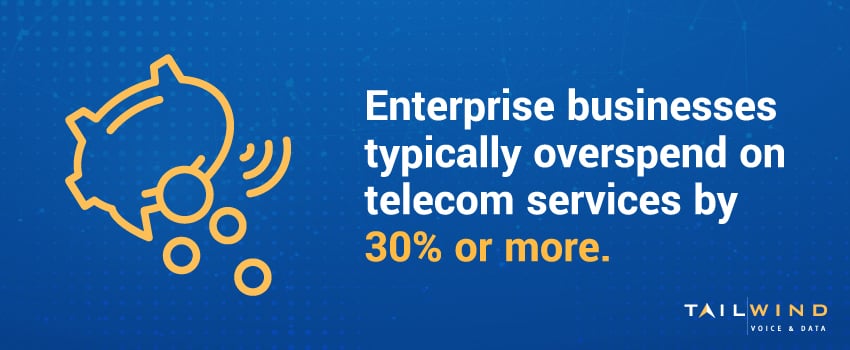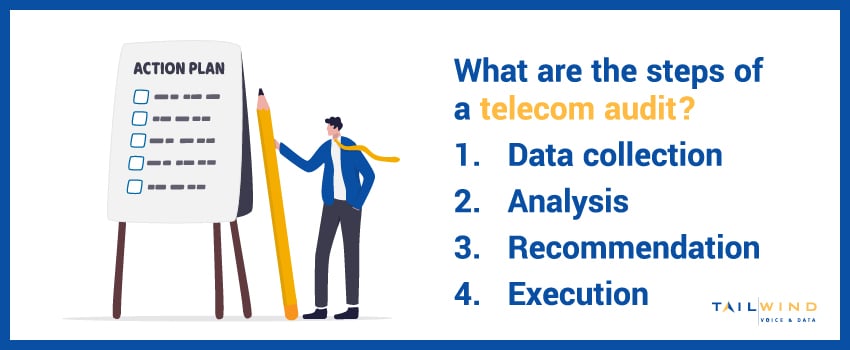Enabling seamless communication across multi-location businesses is harder than ever before. Hybrid and remote work models, cloud adoption, and evolving consumer demands require effective internal and external communication systems – but providing enterprise-level telecommunications while keeping costs in check is easier said than done. On top of these challenges, IT and finance teams are forced to juggle multiple telecom invoices, bills, and carriers across geographically dispersed locations.
Many enterprises overspend on telecom services by 30% or more,1 often due to issues like missed billing errors and duplicate services. In this blog, we’ll explain how a telecom audit can help you uncover savings opportunities and eliminate unnecessary spending so you can optimize your organization’s voice and data services.
What Is a Telecom Audit?
A telecom audit is an in-depth analysis of your organization's telecom environment, including phone, internet, video conferencing, and other communication expenses across all locations. The key aspects include:
- Reviewing telecom bills and contracts for inaccuracies or overcharging
- Analyzing usage trends to right-size service plans based on actual needs
- Pinpointing security gaps in your telecom infrastructure
- Identifying redundant services and obsolete telecommunications equipment
- Uncovering newer technologies to improve productivity
Global spending on telecom is predicted to reach $1,595 billion globally in 2024.2 For multi-location companies, the numbers can stack up quickly without proper oversight. The goal of an audit is to optimize your telecommunications services and expenses, resulting in significant cost savings and increased efficiency.

Why Do Multi-Location Businesses Need Telecom Audits?
With employees, operations, and customers spread across multiple sites, effective communications are essential. However, several factors can lead to telecom waste:
Duplicate Services
With various locations purchasing telecom services independently, there are often overlapping tools and subscriptions across sites without coordination. For example, multiple offices may be paying for separate web conferencing solutions. Identifying and eliminating such duplicate services means cost savings from canceled redundant expenditures.
Changing Needs
As your locations, staff, and customers grow, so do your connectivity requirements. Services and equipment that were adequate a few years ago become obsolete, and failing to identify and migrate from outdated systems leads to productivity lags.
Billing Errors
With multi-location operations relying on various telecom carriers, invoice formats often differ across providers. Combined with frequently changing rates and complex fee structures, this opens the door for errors that are hard to catch internally.
Compliance Risks
Maintaining security, regulatory, and corporate policy compliance across distributed sites poses implementation and governance issues. Any gaps in security, like outdated encryption on networking hardware, can expose your business to non-compliance penalties or cyber attacks.
Limited Visibility
Without enterprise-grade telecom management platforms, most multi-site organizations lack unified visibility and control over telecom inventory and expenses across locations. This severely limits the ability to optimize costs based on data insights.
Telecom Audit Methodology
Telecom audits typically follow a 4-step methodology, which includes:
- Data Collection: Your audit provider will gather billing and contractual documents related to your company's voice, data, wireless, and conferencing services across all locations.
- Analysis: They then analyze the compiled telecom data to identify optimization areas related to duplicate services, unused equipment, billing errors, and network vulnerabilities.
- Recommendation: Based on the audit analysis, your telecom auditing provider will offer cost-saving recommendations aligned to your business priorities, growth roadmap, and telecom needs.
- Execution: The right provider will also help implement the recommendations by coordinating with telecom service providers, negotiating enterprise contracts, upgrading systems, or migrating obsolete equipment.

What Are the Benefits of a Telecom Audit?
While cost savings are the biggest advantage of telecom expense audits, these services deliver several other tangible and intangible benefits. Some of these benefits include:
Enhanced Visibility
Telecom audit solutions provide complete visibility into spending and usage trends across all locations on a single integrated platform, allowing for data-driven decision-making in optimizing your telecom infrastructure and related costs.
Improved Compliance
A telecom audit provider can ensure your services and equipment adhere to industry regulations for data security, record-keeping, HR policies, and others. By filling in any security and compliance gaps, you can reduce risks of penalties or litigation.
Higher Productivity
Optimizing your voice and data systems allows personnel to seamlessly communicate and collaborate across different locations, directly improving workflow efficiencies and productivity.
Better Customer Service
Upgrading telecom equipment and networks allows your support teams to provide more reliable, responsive customer service. This leads to higher first-call resolution, faster issue resolution, and lower customer effort, ultimately improving satisfaction.
Increased Agility
Streamlined telecom systems equipped to handle evolving needs can give your organization the foundation to scale faster, enter new markets, and onboard new technologies.
Risk Mitigation
A telecommunications audit can identify and address any vulnerabilities or gaps in disaster recovery across each location, reducing the risk of prolonged downtime, which can impact revenue and customer confidence.
Focus on Core Priorities
With an experienced auditor handling telecom optimization, your IT team can spend less time dealing with network issues and can focus on core projects that directly impact business growth instead.
Telecom Audits vs. Telecom Expense Management: What's the Difference?
Telecom audits and telecom expense management (TEM) are related but distinct processes for optimizing an organization's voice and data spending.
Telecom audits are periodic assessments conducted by third-party vendors to analyze telecom spending and infrastructure in detail. The goal is to uncover savings opportunities, billing errors, unused services, and compliance gaps and provide recommendations.
Telecom Expense Management refers to continuous oversight of telecom inventory and expenses through detailed tracking, allocation, and cost normalization. While TEM provides ongoing visibility, it can be resource-intensive without third-party support.
Together, third-party telecom audit solutions and TEM can provide end-to-end telecom optimization for long-term financial control and cost visibility.
Streamline Your Multi-Location Communications with TailWind
Staying connected across distributed teams and locations is critical for business success, but overspending on telecom services can quickly eat into budgets. By leveraging comprehensive telecom audits, your business can provide the enterprise-grade communications your employees need without compromising on expenses or compliance.
TailWind's experts are uniquely equipped to help you turn the chaos of your enterprise's telecom and IT services into an organized plan and inventory that helps you save on costs. Our telecom audit services will provide you with a glance into expenses and services at all of your locations so you can better understand what you're spending, eliminate unnecessary solutions, and save on costs.
Ready to optimize your communications with a telecom audit? Reach out to TailWind today to get started.
Sources:


